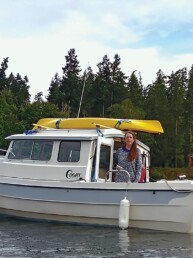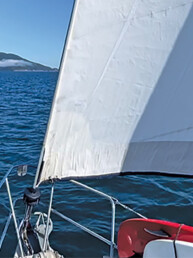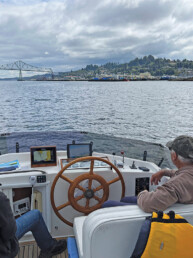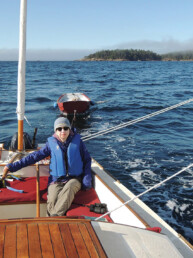This article, by Mark Mosley, with illustrations by his brother, Rob Mosley, originally appeared in the the November 2017 issue of 48° North.
Rob and I grew up with our parents in a modest house on the rocky stretch of beach that runs from Peter Point up the northwest side of Vashon Island. By the time I was nine (and Rob ten), Dad had taught us the rudiments of sailing, to the extent he knew them. Our practice vessel was a cheap molded fiberglass dinghy with a stubby aluminum mast that he had purchased on sale at Sears & Roebuck. By the following spring, we had mastered tacking and jibing and had outgrown that boat, or at least Rob had. We began looking for a bigger boat.
One spring afternoon, Rob came home from a walk, bursting with enthusiasm. He had been down the beach to the south, where he often went with our dog, throwing sticks into the water to fetch. That afternoon he had spotted the sleek white fiberglass-coated wooden hull of a sailboat near a dilapidated boat ramp at a neighbor’s house, some fifteen houses down. The hull had been there long enough to acquire a coat of algae and was on the verge of surrendering to an encroaching army of wild blackberry vines. It obviously had not seen open water in years, though the beach and Puget Sound were less than twenty yards away.

The old house belonged to a man I knew only as Mr. Goodwin, who had lived alone since his wife had passed away several years earlier. Her death had broken something in him, and he had become a recluse. Whenever I caught glimpses of him, he seemed to be glowering. I was careful not to let our dog wander onto his yard. His home always seemed dark, and he rarely came outside. Sometimes, when I passed by on one of my beach walks, a curtain would be pulled slightly askew, and I could see him peering out from the shadows. On those few occasions when I saw him outside, he appeared unkempt and ill at ease.
In his excitement, Rob dragged me down the beach and up the steps of Mr. Goodwin’s porch. He knocked loudly on the door. Then he knocked again, and a third time. Just as I was starting to tug on Rob’s sleeve to go, the door opened.
Mr. Goodwin emerged from the unlit interior and peered at us, blinking in the late afternoon sun. He was unshaven and wore stained, threadbare coveralls, and a greasy plaid shirt with large holes at both elbows. “What do you want?” His voice cracked from lack of use.
Rob’s words came tumbling out in a long-winded narrative about who we were, where we lived, and how we were learning to sail. Finally, Rob pointed to the hull tucked against the house and asked whether it might be for sale.
Rob’s words ran out. We stood in silence on the porch. Mr. Goodwin looked down at his boat and his gaze rested there for a long time. Eventually, he turned back to Rob and me. He looked both of us up and down.
“I’ve seen you boys. Out there.” He gestured with his chin toward the inlet, not breaking eye contact with Rob. “You have some sort of sailing dinghy. What kind a boat is that?”
“It’s a Sea Scouter, sir,” Rob said, proudly giving up the name that Sears & Roebuck had given our little molded fiberglass utility dinghy. As Rob said this I saw, for the first and last time in my life, Mr. Goodwin smile.
We stood again in silence for several minutes as Mr. Goodwin looked back at his boat again. His smile was now gone. Then he looked back at us.
Finally he nodded. “Eighty dollars,” he said, looking Rob straight in the eye. Rob nodded back, saying nothing. Mr. Goodwin turned slowly and went back inside, the door clicking shut behind him.
It took Rob and me most of the summer mowing lawns and picking strawberries and cherries at Wax Orchards to raise the eighty dollars. I’ll never forget the afternoon when Rob finally paddled her home, her mast down and extending several feet off the bow and out over the transom. Rob made two or three trips back to Mr. Goodwin’s house on foot for her sheets and rigging.
Our new sailboat had a tall, lithe wooden mast and a solid tiller and daggerboard, but most of her rigging was rotted. She also had a mainsail, a jib, and a drab undersized spinnaker wadded and shoved into an old canvas sack. The jib and mainsail were well worn and discolored from age and poor storage, but we brought them back by scrubbing them with soap and a little bleach.
We picked more flats of strawberries and cut dozens more lawns to earn enough to buy her new rigging, and we added hiking straps. I sanded and re-varnished her tiller and daggerboard and Rob worked for days to perfect the finish of her mahogany seats and gunwales. One day, at very low tide, we waded out up to our chests and fixed a chain with a buoy to an old half-buried anchor that sat beyond where the rocks give way to mud.
Rob and I sailed that boat almost every day that fall and into the winter, after school and on weekends. Then we sailed her all the next season, and the next, and the next. We learned to single hand her and could sail her all the way ‘round the Island. We’d sail her over to Blake Island with the dog and camp out. And we got pretty good; no one up or down the beach, and possibly no one on Vashon Island, could best us in a comparable class boat.
Our boat was smart and nimble – she would dance with the slightest breeze and she was equally at home, holding steady and true, in winds over twenty knots. Her favorite headings, by far, were beam and broad reaches, when her flat hull would plane and, if the wind and water were just right, she’d scoot across the surface like a hockey puck. But, I loved most having her close-hauled and heeled over, with Rob and me hanging over the windward gunwale, our feet weaved into the hiking straps, cold salt spray in beaming faces.

The summers ended, the divorce came, and Rob and I went off to college and then on with our lives and families. Now, it is fifty years hence and I’m finally learning to sail keelboats in San Francisco Bay, fulfilling a promise I made to myself decades ago. Rob returned to the house on Vashon after Dad died, and he lives there now with his wife. And there on the boat ramp sits the upside down hull of the Flying Dutchman Junior, our “FJ,” the 14-foot, 1950s-era racing class sailing dinghy that Mr. Goodwin had sold to us that afternoon for a tiny fraction of her worth.
A few months ago my son Thomas asked me about her. Why hadn’t we “flipped” her – she would have been worth quite a lot once we had her cleaned up, re-rigged, and varnished? I explained to Thomas that would have been a bad deal for Rob and me because that FJ gave us five brilliant summers that went a long way toward making us the men we are today. We couldn’t replace those summers today at any price. Then, Thomas asked whether Mr. Goodwin knew the boat’s value when he sold her to us, and I assured him he had.
Then why did he practically give her away?
And there came my lesson: If Mr. Goodwin had not given us his prized FJ racing dinghy, and instead sold her to someone who knew what she was and could pay a fair price, he would be gone now, and so would she. But Mr. Goodwin lives on in Rob and me. And the FJ is where she belongs.
What’s Rob going to do with the boat? Thomas asked.
He still sails her from time to time, and so do I whenever I get up there, which is almost never anymore. Nonetheless, I suppose that when Rob’s grown too old to sail her, there’s a good chance a couple of kids might come along the beach and spot her, sitting upside down on the boat ramp at the Vashon house, gleaming brilliant white in the late afternoon sunlight. And they just might ask if she’s for sale.
And I know Rob. He’ll ask the right price.
Mark Mosley lives and sails in the San Francisco Bay area.
Joe Cline
Joe Cline has been the Managing Editor of 48° North since 2014. From his career to his volunteer leadership in the marine industry, from racing sailboats large and small to his discovery of Pacific Northwest cruising —Joe is as sail-smitten as they come. Joe and his wife, Kaylin, welcomed a baby girl to their family in December 2021, and he is enjoying fatherhood while still finding time to sail, make music, and tip back a tasty IPA every now and again.







